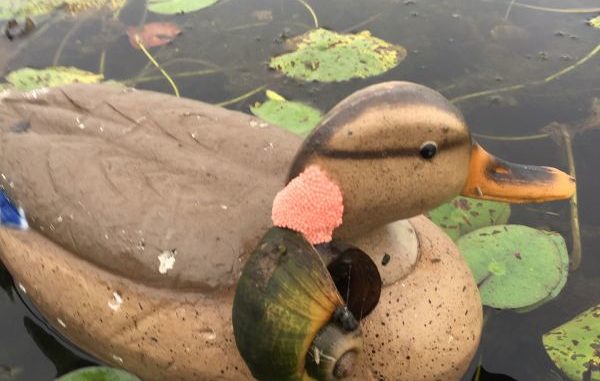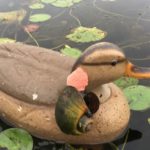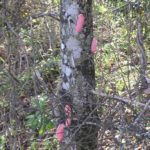
Snails eventually will likely spread to Louisiana’s entire coastal zone, biologist says
Mike Arcement put decoys out on his 2,000-acre lease in Orange Grove southwest of Houma the weekend before duck season started last November, and by opening day many of them were already covered in bright pink egg cases.
Submerged aquatic vegetation on the lease — key forage for ducks — was practically non-existent by the time the season started, as well.
The culprits in both cases were apple snails, an invasive species that arrived in Louisiana about 10 years ago and readily consumes aquatic plants.
A biologist with the Louisiana Department of Wildlife and Fisheries said the snail — which was introduced into the wild via the pet trade — is steadily spreading from east to west across the state’s coastal parishes, and right now at least, little can be done to stop its advance.
“There is no silver bullet pesticide that you can put out there that would just kill the snails and nothing else. That’s the problem,” said Bobby Reed, a senior inland fisheries biologist and LDWF’s aquatic invasive species coordinator. “If you put something out there to kill the snails, you’re going to kill a lot of other stuff inadvertently.”
On Arcement’s Orange Grove lease, he said the number of snails in the ponds is staggering.
“Right now, you could go in our ponds and look on the bottom — the water is clear now — and there are just millions of snails on it,” he said. “It’s nuts.”
The hunters started noticing the snails and their bright pink egg cases in the area about three or four years ago, but Arcement said it wasn’t until the summer of 2015 that vegetation started showing ill-effects from the snails.
And his duck season died right along with it.
“Last summer, vegetation didn’t grow at all,” Arcement said. “And the little they did have — you could go pick up a cluster of grass, and they’d literally have 100 snails on it. It was crazy. On the north side of the Intracoastal from the Houma Nav to the Atchafalaya, it’s been affected pretty negatively.
“That’s a whole lot of primetime hunting areas, and there were no ducks. No vegetation, and no ducks.”
Reed said combatting the spread of the snails is a tough prospect.
Other Gulf states, like Florida, have battled their spread long before they arrived in Louisiana, with little to show for their efforts. The snails are hermaphroditic, which means one snail can produce viable eggs, and Reed said they reach sexual maturity in just 12 to 18 months.
“They generally climb out of the water at night and lay their eggs on a hard surface. I’ve seen egg cases deposited as high as 4 feet above the water,” Reed said. “Most egg cases have a pink cast. If it’s bright pink, it usually means it’s freshly deposited. As time goes on and the young develop inside, it becomes more of an opaque-looking pink, and once they’re all hatched and gone and discarded, the cases are kind of an off-white or gray color.”
Baby snails drop into the water a couple of weeks later, where they are disbursed by wind and currents.
“If the egg case is originally laid on a barge or the side of a tugboat or anything like that, it could end up hundreds of miles from where it’s laid in just a few days,” Reed said. “It primarily likes freshwater, but the literature says it can tolerate salinities up to 10 parts for short periods, so it’s pretty much going to cover the Louisiana coastal zone.”
The snails are already present around the New Orleans metroplex, along the North Shore of Lake Pontchartrain, in lower Terrebonne and Lafourche parishes, and as far north as Port Allen on the east side of the Atchafalaya Basin, Reed said. They’ve also been reported on the west side of the Basin near Highway 190 in Port Barre, and as far west as Mermentau on Bayou Nezpique — too near the state’s rice crop for comfort, he said.
“In Asia, they’re the primary pest of rice plants,” Reed said. “Our state Department of Agriculture — that’s one of their biggest concerns — them getting into rice country.”
Although officials are uncertain if high salinities also played a part in the lack of submerged aquatic vegetation on Arcement’s Orange Grove lease last season, Reed said the snails were likely a big part of the problem.
“It appears localized eat-outs are certainly a possibility,” he said. “We’re not sure if any salinities might have contributed to that as well, but it certainly doesn’t bode well if these animals can reach those types of densities. This could be bad news for a lot of things.
“When you start removing the vegetation to that kind of degree, it can lead to increased saltwater intrusion, wave erosion and further destabilizing the Louisiana coastline.”
Reed said his office is monitoring the spread of the snails, and making the public aware that they’re out there on the landscape. Researchers at Nicholls State University are also studying the snails to see if natural predators might assist in slowing the animals’ spread in Louisiana.
“They’ve identified things like coons and otters, and some long-legged wading birds will try to pull them out of their shells, and they’ve seen young alligators catching and eating them,” Reed said. “So there are some natural predators, but the question is if they can keep up with them.”
Boaters are asked to be vigilant to make sure they aren’t inadvertently spreading egg cases to new bodies of water, he said.
“If they’re in an area staying at a camp and have their boat out in the water for several days, or if they have an area where they keep the boat out there permanently, they certainly want to make sure that before they start moving anywhere, they check the perimeter of the boat and make sure no egg cases are on it,” Reed said. “And if they are, if they’ll just knock them into the water, they’ll sink and drown and you can kill the young when the eggs are in the young stage like that.
“That’s one of the purposes of them laying the eggs above the water line: They can’t survive in water.”
But the adult snails have a wily way of staying on the move, especially after they’ve devoured all of the available vegetation in a localized area, Reed said.
“They have the ability to retain air and close their shell and float. They found in Florida in areas where densities were high, a certain percentage of them would suddenly float and be distributed by the wind and current to potentially new feeding sights,” Reed said. “So just because you see them floating, it doesn’t me they’re dead.”
The biologist also cautioned that the snails are known to carry parasites, so if you or your children handle them, make sure to wash your hands thoroughly afterwards.
“The apple snail carries the larval form of the rat lungworm, and humans can contract it,” Reed said. “Just like people that handle little turtles had the salmonella scare, we recommend people wash and clean up well after handling them because a lot of kids and people keep apple snails as pets.
“Personally, I wouldn’t let my kids handle them at all, but that’s just me. I’ve had courses in parasitology, and there are some nasty parasites out there.”
If you see evidence of snails in areas where you hadn’t noticed them before, Reed asked that you call the state’s Invasive Species Hotline at 225-765-3977 so new populations can be monitored. For more information on the snails from LDWF, click here.
“We don’t know the potential. We’re starting to see these things, and it’s certainly worrisome to us,” Reed said. “I’ve seen us do so much over the years trying to protect our coastline, and we put vegetative plantings out there and so forth, but any time something like this happens where there’s an animal that could potentially destabilize the wetland growth, that certainly bothers me.
“I think this may be just the tip of the iceberg. I don’t want to sound like the doomsday guy, but we’ve seen the invasion of the nutria rat, we’ve seen the invasion of the Asian carp, and this is just another in a long line of invasive species.”
Since they’ve apparently succeeded in devouring so much of the vegetation on his lease in Orange Grove, at this point Arcement is just hoping the snails move on to greener pastures.
“There’s really not a whole lot that can be done about it,” he said. “I’ve read up on them, and they’ll come in and wipe everything out and move. That’s what we’re praying for — that they get out of there.
“I don’t know what else you can do to these damn things.”




